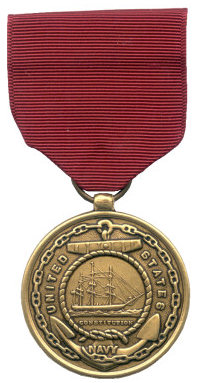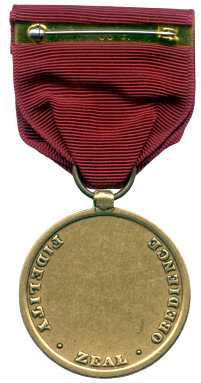Authorization
The Navy Good Conduct Medal was established by SECNAV
on 26 April 1869 to recognize the "all-around" good Navy
enlisted person, well qualified in all phases of conduct and
performance. Effective 1 February 1971, commanding officers
were delegated authority to award the Navy Good Conduct Medal and certificates.
The CNO has review authority over the GCM and designates
specific criteria for the award.
Eligibility Requirements
(a) Service. After 1 November 1963 any 4 years of
continuous active service as an enlisted person in the Regular
Navy or Naval Reserve. Per NAVADMIN 305/95, After 1 January
1996, the qualifying period of eligibility is 3 years vice 4
years for service terminating after that date. For first
enlistments this requirement may be fulfilled by:
1. Continuous active service during a minority
enlistment provided the member concerned served on active duty
to the day preceding his/her 21st birthday even though he/she
extended the enlistment and remained on active duty; or
2. Continuous active service during a minority
enlistment provided the member concerned served on active duty
within 3 months of the day preceding his/her 21st birthday; or
3. Continuous active service during a first
enlistment for 4 years from which the member concerned has been
discharged or released to inactive duty within 3 months of the
date of expiration of enlistment. (This does not apply to those
members who are discharged for the purpose of immediate
reenlistment.)
4. Per NAVADMIN 320/95, any continuous 3 years
or more of qualifying service ending on or after 1 January 1996
warrants entitlement to subject medals. Retroactive computation
or other changes to existing criteria is not authorized. (Ex:
An individual with 3 years 11 months of qualifying service would
be eligible to receive the award on 1 January 1996 and again 1
January 1999 if qualifications are met. However, an individual
with 2 years 6 months of qualifying service on 1 January 1996,
would not eligible for the award until a full 3 years of service
has been completed on 1 July 1996.) Additionally, this change
does not affect the requirements for service stripes, as
dictated by reference (b), Articles 4231 and 4232.
(b) Conduct
1. Within the required period of active
service, the individual must have a clear record (no convictions
by courts-martial, no non-judicial punishments (NJP), no lost
time by reason of sickness-misconduct, no civil convictions for
offenses involving moral turpitude).
a. If confinement as result of conviction
by any courts-martial (general, special or summary) is involved,
a new 3-year period shall begin with date of restoration to duty
on a probationary basis. If confinement is not included in
approved sentence of the courts-martial, a new 3-year period
shall begin with date of convening authority action.
b. If the service record contains an NJP, a
new 3-year period shall begin with the date following the date
of the offense. However, when the date of the offense cannot be
determined, the new 3-year period shall begin with the date
following the NJP.
c. If convicted by civil authorities for an
offense involving moral turpitude, a new 3-year period shall
begin with date of return to active duty status.
d. If the record contains a disqualifying
mark which is not the result of an NJP, the new 3-year period
shall begin with the next date following the date of the mark.
(c) Performance marks required during period of
eligibility.
1. Subsequent to 1 January 1996, no mark below 2.0 in any trait.
2. Between to 31 August 1983 and 31 December
1995 no mark below 3.0 in Military Knowledge/Performance, Rating
Knowledge/Performance, Reliability, Military Bearing, Personal
Behavior and Directing.
3. Prior to 31 August 1983.
a. E-4 and below. No mark below 3.0 in any
trait.
b. E-5 and E-6. No Mark below EEL (Typically
Effective-Lower) in Directing, Individual Productivity,
Reliability or Conduct.
c. E-7 to E-9. No Mark below the bottom 50
percent in Performance, Reliability, Conduct or Directing. If
an individual receives a disqualifying trait mark, a new period
of eligibility would begin on the day following the ending date
of the performance evaluation report which contains the
disqualifying trait mark.
(3) Subsequent to 17 May 1974, for the first award only,
the Good Conduct Medal may be awarded in the following cases
provided conduct and performance requirements are met:
(a) For those individuals who are killed in combat
action against an opposing armed force, or die as a direct
result of wounds received in combat action against an opposing
armed force, the award may be presented posthumously to the next
of kin.
(b) For those individuals who are separated from the
naval service for physical disability as a result of wounds
incurred in combat action against an opposing armed force, or in
the line of duty where such wounds were directly related to
action against the enemy.
(c) For those individuals who die while in a
Prisoner of War (POW) status, the Navy Good Conduct Medal may be presented posthumously
to the next of kin, provided it has been determined
that conduct while in a POW status was acceptable.
(4) A certificate shall be prepared for each award. The
member’s rate, name, branch of service and number of the award
shall be centered in the appropriate spaces. The ending date of
the period of service for which the award was earned shall be
centered after “Awarded for service completed on.” The commanding
officer’s name, rank and branch of service shall be typed
above “Commanding Officer” and his/her signature affixed.
Attachments. A bronze star, 3/16 inch in diameter
will be worn on the suspension ribbon and bar to denote subsequent
awards.
NOTES
1. For personnel who are serving in a first enlistment of 3
years and who have met the eligibility requirements except for
length of service, the Navy Good Conduct Medal may be presented 3 months prior to
the eligibility date.
2. A member not eligible for the Navy Good Conduct Medal under the foregoing
criteria who reenlists or reports for active duty within 3
months after discharge or release to inactive duty is considered
to be serving under “continuous active service” conditions.
While the time between the date of separation and date of return
to active duty is not counted as an interruption of active
service, it may not be included in computing time served. A
member who reenlists or reports for active duty after 3 months
must begin a new 3-year period on the date of reenlistment or
reporting for active duty.
3. An enlisted member appointed a temporary warrant or commissioned
officer is entitled to include such temporary service
upon reverting to an enlisted status for any purpose (including
discharge to accept appointment as a permanent officer). Naval
Academy midshipmen who are not commissioned, but are retained in
the service in an enlisted status, may include such midshipman
service for the purpose of earning the Navy Good Conduct Medal. Except as provided
above, service in warrant, commissioned, or Naval Academy
midshipman status may not be included in computing time served.
4. Active service in a Reserve status credited toward the Naval
Reserve Meritorious Service Medal may not be credited for the
Navy Good Conduct Medal Award.
5. When the requirements have been met, but it is evident that
the individual is not deserving of this award due to a repeated
record of valid letters of indebtedness, or other acts which are
not in keeping with the high moral standards required of all
Navy personnel, the commanding officer will make appropriate
recommendations to CNO (N09B13) stating the reasons.
6. If there is insufficient evidence in a member’s service
record to determine eligibility for the Navy Good Conduct Medal or subsequent
award, a copy of service record page 9, Enlisted Performance
Record, (NAVPERS 1070/609) should be requested from BUPERS in
order to complete the service record and determine the member’s
eligibility for the award.



